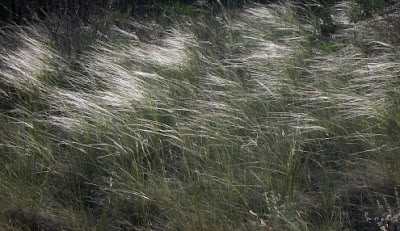Sunday, June 07, 2015
Pliocene Grasses
The Pliocene followed the Miocene about 5.3 million years ago. Continuing tectonic movements finally affected weather patterns. The collision of the Eurasian and Indo-Australian plates and subsequent uplift of the Himalayas modified air currents from Arabia to the Pacific.
The new Indian and Asian monsoons created unique fire regimes. Grasses grew rapidly during very wet seasons, then dried and burned at the end of dry seasons to release carbon dioxide into the atmosphere. Lightening fires occurred several times a decade.
The Caribbean plate shifted a little west to connect North and South America. Water no longer flowed between the Pacific and the Atlantic. The second got less rainfall and grew saltier than the first.
The continued rise of the Rockies may have modified the jet stream’s path. The conjunction of Eurasia and Africa created a temporary rise in the salinity of water in the Mediterranean area.
Changes in oceans delimited Pliocene boundaries. The Zanclean Flood into the Mediterranean marked the beginning. The replacement of the calcareous nanoplankton Triquetrorhabdulus rugosus by another calcareous plankton, Ceratolithus armatus, defined the close.
All trees, flowering plants, and grasses use photosynthesis to convert atmospheric carbon dioxide and soil water into food. Most use a biochemical process called the C3 pathway. About 7 million years ago, grasses utilizing a different method, the C4 pathway, began displacing woodlands and C3 grasslands. The new grasses in Asia could regrow rapidly after fires.
The C4 pathway first evolved much earlier, maybe 30 million years ago, possibly in response to decreasing levels of carbon dioxide levels during the Oligocene that preceded the Miocene. It was reinvented by at least 45 plant lineages, probably in response to other needs.
On the North American plains it’s favored today by drought resistant grasses. In my yard, black grama and ring muhly are C4 plants, needle grass and June grass are C3. The first two are warm weather plants that bloom during the late summer monsoons; the others are cool weather ones that are blooming now.
In southwestern Africa, Sebastian Hoetzel’s team found C4 grasses spread "alongside increasing aridity and enhanced fire activity." Their off-shore drilling rig found grass pollens blown from the Kalahari were 30% of the total 8.4 million years ago. They had increased to 70% by 6.8 million years ago. Plant waxes indicated the C4 grasses were initially insignificant, but became dominant about 6 million years ago. At the same time, the amount of charred particles in the deep sea sediments increased between 7.1 and 5.8 million years ago.
In the Awash Valley of northeastern Africa, Thure Cerling’s group discovered savannas replaced woodlands about 6 million years ago. They existed in the years when the Homo genus was diverging. Savannas, by definition, are no more than 40% trees, woodlands no more than 80%. Forests have even more trees.
The transition to C4 vegetation did not occur in the eastern Mediterranean, according to Erika Edward’s team, even though it was at the same latitude as the North American plains and China where the change did occur. Robert Thomas and Margaret Orr noted temperate grasslands lacked the trees found on savannas and had greater rainfall than steppes.
The two grasslands supported different animal communities. Today, rhinoceroses, wild horses, lions, wolves, jack rabbits, deer, and foxes are associated with prairies, while steppes have badgers. Savannas, on the other hand, support modern day antelope, buffalo, lions, leopards, hyenas, and elephants.
In the Sand Hill prairies of Nebraska, Timothy Heidorn and Anthony Joern found modern grasshoppers preferred C3, if given a choice, but ate whichever was available. The biologists thought the reason was C4 leaves were less nutritious. The thick cells walls characteristic of its pathway made it difficult for insects to access and digest the leaves’ protein and carbohydrates.
Notes:
Cerling, Thure E., et alia. "Woody Cover and Hominin Environments in the past 6? Million Years," Nature 476:51-56:2011.
Heidorn, Timothy and Anthony Joern, "Differential Herbivory of C3 versus C4 Grasses by the Grasshopper Ageneotettix deorum (Orthoptera: Acrididae)," Oecologia 65:19-25:1984.
Edwards, Erika J., Colin P. Osborne, Caroline A. E. Strömberg, Stephen A. Smith, and C4 Grasses Consortium. "The Origins of C4 Grasslands: Integrating Evolutionary and Ecosystem Science," Science 328:587-591:2010.
Hoetzel, Sebastian, Lydie Dupont, Enno Schefuß, Florian Rommerskirchen, and GeroldWefer. "The Role of Fire in Miocene to Pliocene C4 Grassland and Ecosystem Evolution," Nature Geoscience 6:1027_1030:2013. They used the equipment of the Ocean Drilling Program, which
is sponsored by National Science Foundation and the Joint Oceanographic Institutions. The latter is chaired by James D. Watkins, retired US Navy admiral.
Keeley, Jon E. and Philip W. Rundel. "Fire and the Miocene Expansion of C4 Grasslands," Ecology Letters 8:683-690:2005.
Thomas, Robert and Margaret Orr. "Savanna", 1999, and "Colorado Prairie," 2001, in Charles Webber, California Grassland, 2002, reproduced on the University of California at Berkley’s Museum of Paleontology’s website at "The Grassland Biome."
University of Utah. "Six Million Years of Savanna: Grasslands, Wooded Grasslands Accompanied Human Evolution," ScienceDaily, 3 August 2011.
Photographs:
1. Needle grass, Stipa comata.
2. Ring muhly, Muhlenbegia torreyi. Each year the new growth is along the outer edge of the previous growth. The resulting rings capture water that nurses seeds of other plants.
3. Black grama, Bouteloua eriopoda. It also grows in rings, but the center usually remains alive.
4. June grass, Koeleria cristata. It tends to sprout when it’s wet in the spring, then die in the heat of summer when it doesn’t get the water it needs.
Subscribe to:
Post Comments (Atom)




No comments:
Post a Comment